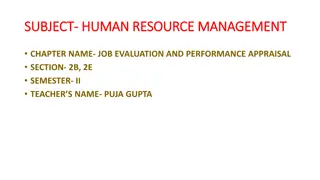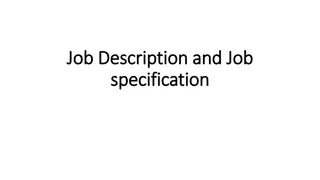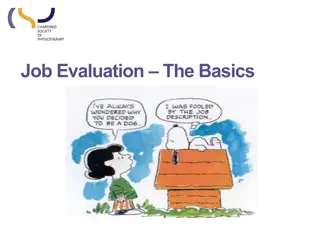Job Evaluation: Process and Importance
Job evaluation involves systematically analyzing and assessing the relative worth of different jobs within an organization. It helps determine job hierarchy, fair wages, and minimize discrimination. The process includes gathering job-related data, comparing job duties, and ensuring equitable pay based on job value. Job evaluation plays a crucial role in organizations by enabling fair comparisons among jobs and helping to make consistent judgments.
Download Presentation

Please find below an Image/Link to download the presentation.
The content on the website is provided AS IS for your information and personal use only. It may not be sold, licensed, or shared on other websites without obtaining consent from the author.If you encounter any issues during the download, it is possible that the publisher has removed the file from their server.
You are allowed to download the files provided on this website for personal or commercial use, subject to the condition that they are used lawfully. All files are the property of their respective owners.
The content on the website is provided AS IS for your information and personal use only. It may not be sold, licensed, or shared on other websites without obtaining consent from the author.
E N D
Presentation Transcript
JOB EVALUATION Dr.Sapna Awasthi
OUTLINE : Basic approach to Job Evaluation. The importance of Job Evaluation effectiveness. Important methods of Job Evaluation. Conclusion
What is job evaluation? Job evaluation is the process of analyzing and assessing the systematically to ascertain their relative worth in an organization. Job is evaluated on the basis of their content and is placed in the order of their importance. various jobs
THE FOLLOWING OBJECTIVES ARE DERIVED FROM THE ANALYSIS To gather data and information relating to job description, job specification and employee specifications for various jobs in an organization To compare the duties, responsibilities and demands of a job with that of other jobs To determine the hierarchy and place of various jobs in an organization. To determine the ranks or grades of various jobs To ensure fair and equitable wages on the basis of relative worth or value of jobs. To minimize wage discrimination based on sex, age, caste, region, religion etc.
THE ROLE OF JOB EVALUATION IN ORGANIZATIONS Job evaluation includes comparative processes due to the fact that the relations and dependencies among the jobs have to be explained. This consists of an essential determinant that allows the management (through the analysis of the targets, achievements and factors that influence the requirements of the jobs) to assign the corresponding proportions of every job. For this reason job evaluation usually includes an extensive analysis of the roles, the objectives and the corresponding actions and achievements of the jobs. The outcome of this analysis is the establishment of structures that aid the comparison among the jobs and support the evaluators to make consistentand reasonable judgments.
PRINCIPLES OF JOB EVALUATION PROGRAM Rate the job but not the employee. Rate the elements on the basis of the job demands. The elements selected for rating should be easily understood. The elements should be defined clearly and properly selected. Employees concerned and the supervisors should be educated and convinced about the program Supervisors should be encouraged to participate in ratingthe jobs. Secure employee cooperation by encouraging them to participate in the ratingprogram. Discuss with the supervisors and employees about rating butnot about assigning money values to the points. Do not establish too many occupationalwages.
JOB EVALUATION PROCESS Objectives of JobEvaluation Job Analysis JobDescription Job Specification Job EvaluationProgram Wage Survey EmployeeClassification
RANKING METHOD This is the simplest, the most inexpensive and the most expedient method of evaluation. Each job is considered as a whole and is then given a ranking in relation to all other jobs. A ranking table is then drawnup and the ranked jobs grouped into grades. Job title Grade Salary (Taka) Engineer 9 25000 Accountant 8 20000 Purchase assistant 7 18000 Machine Operator 6 15000 Office Boy 5 10000 The main disadvantage of this method is that it lacks substantiating data for later use in justifying the relative position given certain jobs. So this method is not suitable for largeorganization.
CLASSIFICATION METHOD Classification systems define the value of jobs, people, or teams with written standards for a hierarchy of classification level. It involves only matching a specific job with a list of tasks in a predeterminedlabor grade. Each grade has asset moneyrate. PROCESS: 1.Develop descriptions classes/grade 2.Develop standards for each category by describing the key characteristics of those jobs in the category. 3.Match jobs to the categories based on the similarity of tasks. RESULTS: Job classes are classified like managerial , office clerical and then jobs are assigned to these classifications. for a category of jobs job
Classification Method (cont) ADVANTAGES: Jobs, people, and teams can be quickly slotted into the structure Classification levels have face validity for employees Standards to establish value are made explicit Disadvantages Many jobs, people, or teams do not fit neatly into a classification level Extensive judgment is required Differences between classification levels may not be equal Creates status hierarchies within organizations Extensive administration required .
POINT METHOD The system starts with the selection of job factors, construction of degrees for each factor, and assignment of points to each degree. Different factors are selected for different jobs, with accompanying differences in degrees and points. The most popular number of factors is between ten and fifteen . Effort Physical demand Mental and / or visual demand Skill Education Experience Initiative & ingenuity Responsibility Responsibility for equipment or process Responsibility for materials or product Responsibility for safety of others Job Conditions Working conditions Hazards
POINT METHOD (CONT) PROCESS: A set of compensable factors are identified Assign points to a these compensable factors based on the perceived importance to the job Once this is dine for all compensable factors, evaluate the level to which each of these factors are present in the job and assign points(weights) accordingly. The points for each factor are totaledto form a score for the job. RESULT: Jobs are then grouped by total score and assigned to salary grades so that jobs with the highest points would have the highest pay.
1st Degree 2nd Degree 3rd Degree 4th Degree 5thDegree Factors SKILL Education 15 30 45 60 75 Experience 20 40 60 80 100 Initiative andIngenuity 15 30 45 60 75 EFFORT Physicaldemand Mental or visualdemand 10 20 30 40 50 5 10 15 20 25 RESPONSIBILITY Equipment or process 5 10 15 20 25 Material or product 5 10 15 20 25 Safety of others 5 10 15 20 25 Work of other job conditions 5 10 15 20 25 JOB CONDITIONS Working conditions Unavoidable hazards 10 20 30 40 50 5 10 15 20 25
THE FACTOR COMPARISON METHOD This method is based on the assumption that all jobs contain certain common factors to determine the worth of jobs. These factors may differ in the degree to which they are present in different jobs. Typicallythe number of compensable factors is small (4 or 5). PROCESS: 1. Select the set of BenchmarkJobs 2. Rank the Benchmark jobs on the basis of each compensable factor. 3. For each Benchmark job, allocate market pay across the compensable factor 4. Determine the pay for each job by adding up the payfrom each compensablefactor. RESULTS: Pay Range= Pay from skill + Pay from effort + Pay from responsibility + Pay from workingconditions
THE FACTOR COMPARISON METHOD (CON T) Advantages: Analytical and objective Reliable and valid as each job is compared with otherjob Disadvantages It is difficult to understand and explain Using the same criteria to access all job is not accurate asjobs differ within organization as with point method. Time consuming and costly.
CONCLUSION A job evaluation scheme should be chosen cautiously. It should administered on the basis of employment market, demand for labor, bargaining power of the parties & job conditions. be devised and

 undefined
undefined


























